Photographing Glory & Tragedy:
Larrabee & Zelma’s Documentation of World War II
Nicolas Montenegro
Wall Panel
The Second World War presented an extraordinary opportunity for photojournalists to expand and redefine notions of art. War and combat correspondents from around the world, utilizing advancements in camera technology, risked their lives to capture the spirit of warfare on film (Baltermans). The revolutionary 35mm handheld cameras, like the German Leica models used by Georgi Zelma, allowed photographers to experience and document even the most intense battlefields and environments of the war (Costa). With this unprecedented degree of involvement in the field, combat correspondents became remarkably familiar with the idiosyncrasies of war, and acquired the ability to present their photographs as works of art. This exhibition features a collection of exclusive works captured by British war correspondent, Constance Stuart Larrabee, and Soviet combat correspondent, Georgi Zelma, during their time reporting on the Allied campaigns in the eastern and western fronts respectively.
Although Zelma and Larrabee are of different nationalities, political backgrounds, genders, and personalities, their photographs share very similar motivations to depict the Second World War in all its glory and tragedy. Their photographs have the unique ability to not only present the Allied forces as the morally just side (Roulet) but also to allow the audience to engage with the war subjectively and make their own profound connections and interpretations with the work (Baltermants). This process is crucial for modern audiences to recognize photography as an integral medium of art, and more importantly, to commemorate significant moments in history.
Object Label 1
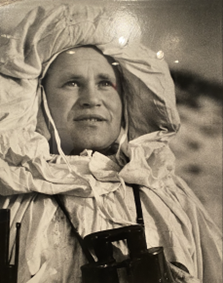
Georgi Zelma Battle for Stalingrad, Hero of Stalingrad, Sniper, Vasily Zaitsev 1943 Vintage gelatin silver print mounted on board
The Battle of Stalingrad is notorious for being one of the most gruesome and costly campaigns in the history of warfare. Victory was seen as a pivotal moment in the war, with Soviet journalist Vasily Grossman writing, “The outcome…was to determine the map of the post-war world.” (Popoff) This photograph of Soviet marksman and war hero, Vasily Zaitsev, exemplifies notions of Soviet nationalism and military excellence that were paramount to victory in Stalingrad. The focus on Zaitsev’s face as he looks up expressing a grin, and the candid appearance of his binoculars and rifle, gives the impression of heroism and professionalism.
Object Label 2
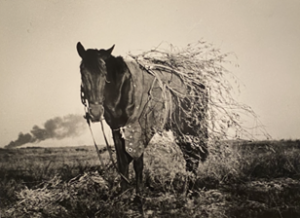
Georgi Zelma
Battle of Stalingrad (Camouflaged horse with limbs of bushes attached)
1942
Vintage gelatin silver print mounted on board
Having built his reputation as a major contributor in the Constructivist movement through the 1920’s (“Georgi Zelma”), Zelma was driven by demonstrating how materials behave under harsh conditions (Gough). This photograph may epitomize those constructivist principles by showing the lengths that Soviet soldiers went to protect a horse from the enemy. The image implies that Soviet Soldiers went through the process of curating tree branches and attaching them to the horse’s coat — all while presumably under fire from the Germans. The determination to preserve what few materials remain is ironic when considering the context; that being, the ultimate manifestation of death and destruction.
Object Label 3
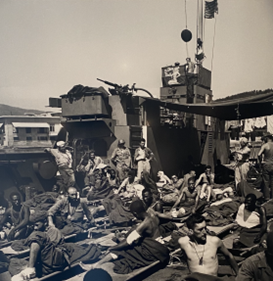
Constance Stuart Larrabee
Evacuating Wounded on Riviera Beachhead
August 1944
Gelatin silver print
As a former student of the Bavarian State Institute for Photography in Munich, Larrabee was well trained in photojournalism and how to effectively operate the standard 35mm camera models commonly used in combat correspondence (McNatt, Costa). One particular trait Larrabee learned amid her studies was to never waste film — crucial to her work during World War II as access to supplies were incredibly limited (Roulet). This photograph, capturing the evacuation of wounded soldiers in France, shows just how tight resources were on the battlefield — with dozens of soldiers needing medical attention all crammed together on a small vessel.
Object Label 4
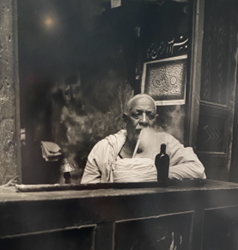
Constance Stuart Larrabee
Seller of Spices in Mussky, Cairo, Egypt
July-August 1944
Gelatin silver print
Often underrepresented in media about war is the struggle and anguish of ordinary civilians coping with perpetual violence and unrest. Much of Larrabee’s work, particularly in Africa, focused on this relatively mundane aspect of war — allowing her to concentrate on transforming public notions of World War II and photography (Roulet). On the surface, this photograph is merely a portrait of a spice merchant enjoying a smoke. However, when viewed with knowledge of the context, a man living through humanity’s greatest atrocity, the work takes on an entirely new meaning. Thus, the conflation of photojournalism and art becomes essential to preserving history.
Object Label 5

Georgi Zelma
Battle for Stalingrad, Preparing for Battle
1943
Vintage gelatin silver print
In the aftermath of World War II, photographs like this one, taken by Zelma in Stalingrad, adopted a whole new meaning. Originally published and approved by the Soviet state in accordance with their ‘propaganda guidelines,’ Zelma’s work was designed to perpetuate the war machine (Baltermants). Today, however, far removed from the days of the war, the significance of the picture is entirely up to the observer’s understanding of World War II — likely involving sentiments of sadness, disbelief, and regret. Photographs, an objective reflection of reality, “strip war of its romantic illusions” (McNatt) and teach humanity the importance of preserving real history (“Photography and museums”).
Works Cited
Baltermants, Dmitri and Alexander Mihailovic. “Armed Only With a Camera: An Interview with Dmitri Baltermants.” Aperture, no. 116, 1989, pp. 2-7. JSTOR,
http://www.jstor.org/stable/24472223 Accessed February 4, 2023.
Costa, Pat. “Cameras for the World War II Reenactor.” PatCosta.com. September 21, 2015. https://patcosta.com/cameras-in-world-war-ii/ Accessed February 11, 2023.
“Georgi Zelma.” All About Photo. https://www.all-about-photo.com/photographers/photographer/316/georgi-zelma Accessed February 4, 2023.
Gough, Maria. “The Artist as Producer: Russian Constructivism in Revolution.” University of California Press. 2005. https://books.google.com/books?id=KCJHxeNQuGMC&printsec=copyright#v=onepage&q&f=false Accessed February 9, 2023.
McNatt, Glenn. “A woman’s stark images from the front Photography:…” The Baltimore Sun. September 9, 1998. https://www.baltimoresun.com/news/bs-xpm-1998-09-09-1998252019-story.html Accessed February 11, 2023.
“Photography and museums.” The Burlington Magazine, vol. 158, no. 1357, 2016, pp. 243-244. JSTOR, http://www.jstor.org/stable/43858723 Accessed February 5, 2023.
Popoff, Alexandra. “The Battle of Stalingrad.” Vasily Grossman and the Soviet Century, Yale University Press, 2019, pp. 128-151. JSTOR, https://doi.org/10.2307/j.ctvd1c9fm.13 Accessed February 11, 2023.
Roulet, Laura. “Eastern Front — Western Front: World War II Photojournalism by Georgi Zelma and Constance Stuart Larrabee.” American University, College of Arts & Sciences. 2023.
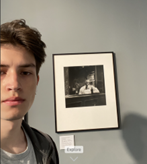
Photographs of the works were taken by me at the Eastern Front — Western Front exhibition in the American University Museum.
